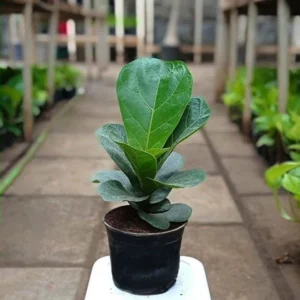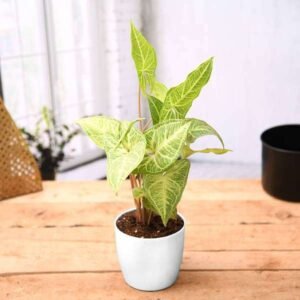Description
Badam Tree, Indian Almond Tree,- Plant
The Badam Tree, scientifically known as Terminalia catappa, is a tropical tree native to the Indo-Pacific region. Renowned for its broad, spreading canopy and distinctive, almond-shaped leaves, this tree not only enhances the beauty of any landscape but also provides shade and habitat for various wildlife. Its edible nuts are a source of nutrition and have been used in traditional medicine for centuries.
What makes the Badam Tree special is its adaptability to different soil types and climates, making it a popular choice for both urban and rural settings. Its vibrant foliage transitions from green to a stunning red and yellow in the fall, creating a picturesque scene. Additionally, the tree’s ability to sequester carbon makes it an excellent choice for environmentally conscious gardeners.
One of the standout features of the Badam Tree is its resilience against drought and salt, making it ideal for coastal areas. Its large, leathery leaves not only provide shade but also contribute to soil health by returning nutrients as they decompose.
Growing Instructions:
- Plant in well-drained soil with a pH of 6.0 to 7.5.
- Choose a sunny location, as the tree thrives in full sunlight.
- Space the trees at least 20 feet apart to allow for their expansive growth.
- Water regularly during the first year to establish a strong root system.
Care Instructions:
- Prune annually to maintain shape and remove any dead or diseased branches.
- Fertilize with a balanced fertilizer during the growing season.
- Monitor for pests such as aphids and scale; treat with organic insecticides if necessary.
- Mulch around the base to retain moisture and suppress weeds.
Uses:
- Edible nuts can be consumed raw or roasted.
- Leaves are used in traditional medicine for their anti-inflammatory properties.
- Wood is durable and often used in furniture making.
- Provides excellent shade for gardens and parks.
Fun Facts:
- The Badam Tree is often referred to as the “Sea Almond” due to its coastal adaptability.
- Historically, the tree has been used in Ayurvedic medicine for its numerous health benefits.
- Its large, fallen leaves create a natural mulch that enriches the soil.
- The tree can grow up to 30 meters tall and live for over 100 years!
Environmental Impact:
The Badam Tree plays a crucial role in combating climate change by absorbing carbon dioxide. Its extensive root system helps prevent soil erosion, especially in coastal areas, while its shade provides a habitat for various species, promoting biodiversity.
Badam Tree Benefits
The Badam tree, also known as the Indian Almond tree, is not just a pretty face in the botanical world. Its leaves, bark, and nuts are packed with health benefits that could make even your gym trainer jealous. Rich in antioxidants, the nuts are a crunchy delight that can help lower cholesterol and improve heart health. Plus, the tree itself provides shade that’s perfect for lazy afternoons. Who needs a beach when you have a Badam tree to lounge under?
Indian Almond Tree Uses
The Indian Almond tree is the Swiss Army knife of the plant world. Its leaves can be used for medicinal purposes, while the nuts are a tasty snack. The wood is durable and can be used for furniture, and the tree itself provides excellent shade. It’s like having a multi-talented friend who can cook, fix your furniture, and still look good doing it. Who knew a tree could be so versatile?
Badam Tree Growth Rate
If you’re looking for a fast-growing friend, the Badam tree is your go-to. This tree can grow up to 2 feet a year, making it the Usain Bolt of the plant kingdom. With the right conditions—plenty of sunlight and well-drained soil—you’ll have a towering beauty in no time. Just remember, patience is key; even the fastest trees need a little time to reach their full glory.
Badam Tree in Landscaping
The Badam tree is the ultimate showstopper in landscaping. With its broad canopy and stunning foliage, it can transform any dull garden into a tropical paradise. Plant it as a focal point or use it to create a natural privacy screen. It’s like the celebrity of the garden world, drawing attention and admiration wherever it goes. Plus, who wouldn’t want to say they have an Indian Almond tree in their backyard?
Indian Almond Tree Fruit
The fruit of the Indian Almond tree is a delightful treat for both humans and wildlife. These greenish-yellow drupes are not just eye candy; they’re packed with nutrients. While they may not be the most popular fruit in the grocery store, they can be used in jams, jellies, and even as a natural remedy. It’s like the underdog of the fruit world, waiting for its moment to shine.
Badam Tree Shade
If you’re in search of the perfect shade tree, look no further than the Badam tree. Its expansive canopy provides a cool refuge from the blazing sun, making it an ideal spot for picnics or afternoon naps. It’s like having your own personal umbrella, but way more stylish. Plus, the dappled sunlight filtering through the leaves creates a magical atmosphere that even fairies would envy.
Terminalia Catappa Pests
Every tree has its enemies, and the Terminalia catappa is no exception. While it’s generally pest-resistant, it’s wise to keep an eye out for common culprits like aphids and caterpillars. Think of it as a game of hide-and-seek; you’ll need to be vigilant to catch them before they wreak havoc. A little neem oil or insecticidal soap can send these pests packing, ensuring your Badam tree remains the belle of the ball.
Badam Tree Soil Requirements
The Badam tree is not picky, but it does have its preferences. It thrives in sandy, well-drained soil, making it the Goldilocks of the plant world—not too wet, not too dry, but just right! If your soil is heavy and clay-like, consider amending it to create a more hospitable environment. After all, a happy tree is a thriving tree, and who wouldn’t want to pamper their leafy friend?
Indian Almond Tree History
The Indian Almond tree has a rich history that dates back centuries. Native to tropical regions, it has been cherished for its beauty and utility. Ancient cultures used its leaves for medicinal purposes, while sailors valued its wood for shipbuilding. It’s like the tree that has seen it all, from ancient civilizations to modern gardens. Planting one is like inviting a piece of history into your backyard, ready to share its stories.







 Creeping fig Plant, Ficus pumila - Plant
Creeping fig Plant, Ficus pumila - Plant  Peace Lily, Spathiphyllum - Plant
Peace Lily, Spathiphyllum - Plant  Shami, Tree of Dhanishta Nakshatra, Capricorn or Makar Rashi - Plant
Shami, Tree of Dhanishta Nakshatra, Capricorn or Makar Rashi - Plant  Raat Ki Rani, Raat Rani, Night Blooming Jasmine - Plant
Raat Ki Rani, Raat Rani, Night Blooming Jasmine - Plant 

Reviews
There are no reviews yet.